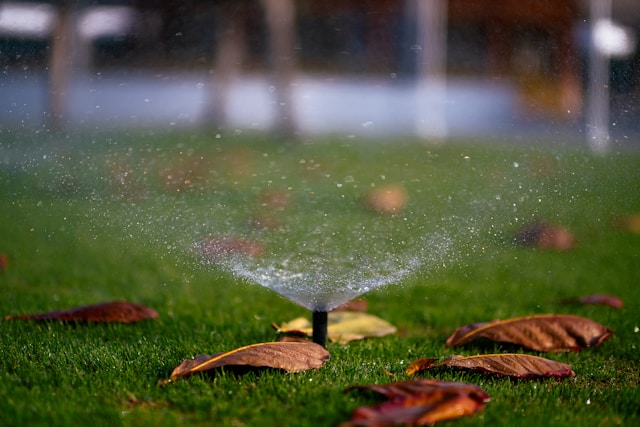5 Signs Your Sprinkler System Needs Attention—Before It Costs You
August 4, 2025Your sprinkler system reveals problems through five key indicators: uneven watering patterns with brown patches or oversaturated zones, unexplained spikes in water bills, visible pooling or runoff in your landscape, decreased water pressure affecting head performance, and sprinkler heads failing to pop up or rotate properly. Addressing these issues promptly prevents extensive landscape damage, conserves water, and helps you avoid costly emergency irrigation system repair in Peoria, AZ. The following signs warrant immediate inspection.

Introduction
While many homeowners invest in sprinkler systems to maintain lush landscapes, they often overlook signs of deterioration until major problems arise. Your irrigation system silently waters your property until something fails—typically during peak heat when your plants need it most.
In Arizona’s harsh climate, regular sprinkler inspection becomes essential. Small issues quickly escalate into costly repairs, wasted water, and damaged vegetation. Learning to identify warning signs can save thousands in water bills and landscape replacement.
You’ll need to recognize subtle indicators of impending failure. This proactive approach guarantees your system continues functioning efficiently through Arizona’s unforgiving summer months.
Sign #1: Uneven Watering Patterns
The most immediate signal of sprinkler malfunction appears directly on your lawn’s surface. Brown patches adjacent to oversaturated zones indicate uneven watering distribution—typically caused by misaligned heads, improper pressure, or clogged nozzles.
Examine your lawn during daylight operation. You’ll notice spray patterns failing to achieve proper overlap, creating dry zones where coverage is insufficient. Meanwhile, puddles form in areas receiving excessive moisture. This imbalance stresses plants, wastes water, and increases utility costs.
Address uneven watering promptly by inspecting each head for proper rotation, consistent spray patterns, and appropriate placement relative to your landscape’s specific hydration requirements.
Sign #2: Unusually High Water Bills
Check for wet spots, unusual pooling, or lush patches in your landscape. These visual cues, combined with higher water bills, confirm irrigation system failures. Prompt diagnosis prevents not only excessive water costs but also potential landscape damage and foundation issues from persistent leakage.
Sign #3: Water Pooling or Runoff
Excessive pooling or runoff across your landscape indicates serious sprinkler system malfunctions that demand immediate attention. When water accumulates rather than absorbs properly, you’re facing potential pipe cracks, damaged valve seals, or improper system timing.
Pooling occurs when application rates exceed soil infiltration capacity, while runoff happens when water flows away from target zones. Both waste resources and create liability hazards like slippery surfaces and foundation damage.
Check for broken heads, misaligned nozzles, or excessive run times. Adjust your controller’s cycle-soak settings to allow proper absorption between waterings. These adjustments prevent erosion while ensuring your landscape receives water where it’s needed most.
Sign #4: Low or No Water Pressure
Several telltale signs of low water pressure in your sprinkler system can compromise your landscape’s health and appearance. When sprinkler heads barely pop up, emit weak streams, or fail to rotate properly, you’re experiencing pressure problems within your irrigation network.
Check for clogged filters, partially closed valves, or pipe obstructions as common culprits. Simultaneous running of multiple zones or water-intensive household appliances can also deplete available pressure. In older systems, pipe corrosion or mineral buildup progressively restricts flow.
Address pressure issues promptly—they often indicate developing problems that will worsen without intervention.
Sign #5: Sprinkler Heads Not Popping Up or Rotating
When sprinkler heads fail to pop up or rotate properly, you’re facing a fundamental operational issue that directly impacts your irrigation coverage.
The culprits are typically mineral deposits, debris accumulation, or mechanical wear. Inspect the heads for sediment buildup inside the nozzles or around the riser stems. This obstruction prevents the water pressure from lifting the mechanism effectively.
Regular sprinkler head maintenance includes cleaning internal components, lubricating rotating parts, and ensuring proper alignment. If heads remain stuck after cleaning, the internal spring may be damaged or the gear drive might require replacement.
Don’t ignore these symptoms—partial rotation creates dry spots while stuck heads waste water underground.
Benefits of Working with Sergios Lawn Services
Working with Sergios Lawn Services offers homeowners extensive sprinkler system expertise that’s tailored specifically for Arizona’s challenging climate conditions.
Our technicians conduct thorough diagnostics using advanced tools to identify inefficiencies invisible to untrained eyes. We don’t just patch problems—we implement sustainable solutions that extend system longevity while reducing water consumption.
When you need irrigation system repair in Peoria, AZ, you’ll benefit from our same-week scheduling, transparent pricing, and warranty-backed workmanship. Our smart irrigation upgrades integrate weather sensors and zone-specific programming that automatically adjusts to seasonal changes, dramatically cutting water waste while maintaining landscape health.
Conclusion
Maintaining your sprinkler system’s prime functionality isn’t just about aesthetics—it’s a critical investment in your property’s value and landscape health.
By recognizing warning signs early—uneven watering patterns, unexpected puddles, rising water bills, or visible damage—you’ll prevent minor issues from escalating into costly repairs. Regular inspections and timely maintenance save water, money, and your landscape.
Consider upgrading to smart irrigation systems that automatically adjust to weather conditions and soil moisture levels. These technologies maximize water usage while maintaining peak growing conditions.
Don’t wait until your lawn shows distress. Proactive sprinkler maintenance guarantees your Arizona landscape thrives year-round despite challenging desert conditions.
 Sergios Lawn Services
Sergios Lawn Services